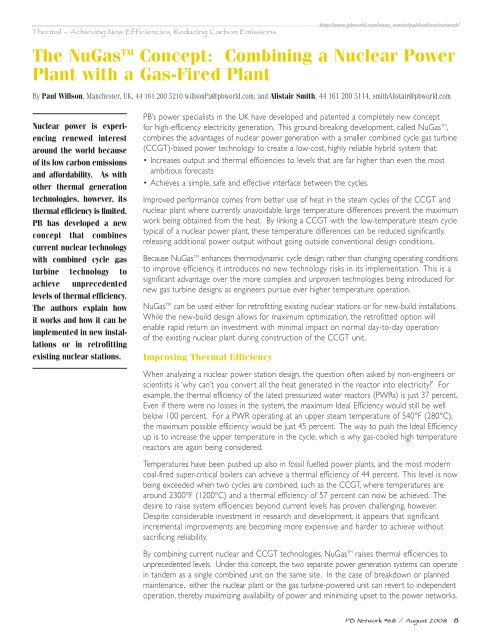Innovation in Global Power - Parsons Brinckerhoff
Innovation in Global Power - Parsons Brinckerhoff
Innovation in Global Power - Parsons Brinckerhoff
Create successful ePaper yourself
Turn your PDF publications into a flip-book with our unique Google optimized e-Paper software.
Thermal – Achiev<strong>in</strong>g New Efficiencies, Reduc<strong>in</strong>g Carbon Emissions<br />
http://www.pbworld.com/news_events/publications/network/<br />
The NuGas TM Concept: Comb<strong>in</strong><strong>in</strong>g a Nuclear <strong>Power</strong><br />
Plant with a Gas-Fired Plant<br />
By Paul Willson, Manchester, UK, 44 161 200 5210 willsonPa@pbworld.com; and Alistair Smith, 44 161 200 5114, smithAlistair@pbworld.com<br />
Nuclear power is experienc<strong>in</strong>g<br />
renewed <strong>in</strong>terest<br />
around the world because<br />
of its low carbon emissions<br />
and affordability. As with<br />
other thermal generation<br />
technologies, however, its<br />
thermal efficiency is limited.<br />
PB has developed a new<br />
concept that comb<strong>in</strong>es<br />
current nuclear technology<br />
with comb<strong>in</strong>ed cycle gas<br />
turb<strong>in</strong>e technology to<br />
achieve unprecedented<br />
levels of thermal efficiency.<br />
The authors expla<strong>in</strong> how<br />
it works and how it can be<br />
implemented <strong>in</strong> new <strong>in</strong>stallations<br />
or <strong>in</strong> retrofitt<strong>in</strong>g<br />
exist<strong>in</strong>g nuclear stations.<br />
PB’s power specialists <strong>in</strong> the UK have developed and patented a completely new concept<br />
for high-efficiency electricity generation. This ground-break<strong>in</strong>g development, called NuGas TM ,<br />
comb<strong>in</strong>es the advantages of nuclear power generation with a smaller comb<strong>in</strong>ed cycle gas turb<strong>in</strong>e<br />
(CCGT)-based power technology to create a low-cost, highly reliable hybrid system that:<br />
• Increases output and thermal efficiencies to levels that are far higher than even the most<br />
ambitious forecasts<br />
• Achieves a simple, safe and effective <strong>in</strong>terface between the cycles.<br />
Improved performance comes from better use of heat <strong>in</strong> the steam cycles of the CCGT and<br />
nuclear plant where currently unavoidable large temperature differences prevent the maximum<br />
work be<strong>in</strong>g obta<strong>in</strong>ed from the heat. By l<strong>in</strong>k<strong>in</strong>g a CCGT with the low-temperature steam cycle<br />
typical of a nuclear power plant, these temperature differences can be reduced significantly,<br />
releas<strong>in</strong>g additional power output without go<strong>in</strong>g outside conventional design conditions.<br />
Because NuGas TM enhances thermodynamic cycle design rather than chang<strong>in</strong>g operat<strong>in</strong>g conditions<br />
to improve efficiency, it <strong>in</strong>troduces no new technology risks <strong>in</strong> its implementation. This is a<br />
significant advantage over the more complex and unproven technologies be<strong>in</strong>g <strong>in</strong>troduced for<br />
new gas turb<strong>in</strong>e designs as eng<strong>in</strong>eers pursue ever higher temperature operation.<br />
NuGas TM can be used either for retrofitt<strong>in</strong>g exist<strong>in</strong>g nuclear stations or for new-build <strong>in</strong>stallations.<br />
While the new-build design allows for maximum optimization, the retrofitted option will<br />
enable rapid return on <strong>in</strong>vestment with m<strong>in</strong>imal impact on normal day-to-day operation<br />
of the exist<strong>in</strong>g nuclear plant dur<strong>in</strong>g construction of the CCGT unit.<br />
Improv<strong>in</strong>g Thermal Efficiency<br />
When analyz<strong>in</strong>g a nuclear power station design, the question often asked by non-eng<strong>in</strong>eers or<br />
scientists is ‘why can’t you convert all the heat generated <strong>in</strong> the reactor <strong>in</strong>to electricity?’ For<br />
example, the thermal efficiency of the latest pressurized water reactors (PWRs) is just 37 percent.<br />
Even if there were no losses <strong>in</strong> the system, the maximum Ideal Efficiency would still be well<br />
below 100 percent. For a PWR operat<strong>in</strong>g at an upper steam temperature of 540°F (280°C),<br />
the maximum possible efficiency would be just 45 percent. The way to push the Ideal Efficiency<br />
up is to <strong>in</strong>crease the upper temperature <strong>in</strong> the cycle, which is why gas-cooled high temperature<br />
reactors are aga<strong>in</strong> be<strong>in</strong>g considered.<br />
Temperatures have been pushed up also <strong>in</strong> fossil fuelled power plants, and the most modern<br />
coal-fired super-critical boilers can achieve a thermal efficiency of 44 percent. This level is now<br />
be<strong>in</strong>g exceeded when two cycles are comb<strong>in</strong>ed, such as the CCGT, where temperatures are<br />
around 2300°F (1200°C) and a thermal efficiency of 57 percent can now be achieved. The<br />
desire to raise system efficiencies beyond current levels has proven challeng<strong>in</strong>g, however.<br />
Despite considerable <strong>in</strong>vestment <strong>in</strong> research and development, it appears that significant<br />
<strong>in</strong>cremental improvements are becom<strong>in</strong>g more expensive and harder to achieve without<br />
sacrific<strong>in</strong>g reliability.<br />
By comb<strong>in</strong><strong>in</strong>g current nuclear and CCGT technologies. NuGas TM raises thermal efficiencies to<br />
unprecedented levels. Under this concept, the two separate power generation systems can operate<br />
<strong>in</strong> tandem as a s<strong>in</strong>gle comb<strong>in</strong>ed unit on the same site. In the case of breakdown or planned<br />
ma<strong>in</strong>tenance, either the nuclear plant or the gas turb<strong>in</strong>e-powered unit can revert to <strong>in</strong>dependent<br />
operation, thereby maximiz<strong>in</strong>g availability of power and m<strong>in</strong>imiz<strong>in</strong>g upset to the power networks.<br />
PB Network #68 / August 2008 8

















